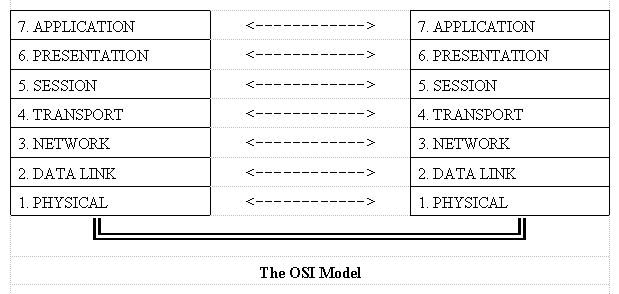
A typical digital communications task, such as checking e-mail on a desktop computer, can be studied at different levels of abstraction. At the highest level, checking e-mail can be considered as one of many applications of digital communications. At the lowest level, bits move from one computer to another. The Open Systems Interconnect (OSI) model provides a useful framework for discussing digital communications from various perspectives.
Sitting in front of a computer screen, users interact with a graphical user interface (GUI) a mouse and a keyboard to send and receive their correspondence with little need to know or care about the process by which such things actually work. Conceptually, an e-mail message goes straight from the e-mail application window on one computer to the e-mail application on another. Having clicked on the 'send' button, a user can be confident the message will arrive at its intended destination rapidly and without error.
APPLICATION <--------> APPLICATION
Similarly, software designers can work at this high level to build application tools. An application communicates with another through a set of well defined commands describing a protocol. At the level of the application, it is sufficient to design a GUI which accepts input from the user and, in response to a button click, issues a properly formatted 'send' command to transmit an e-mail message. At a lower level, perhaps on a command line-interface, a user might have to type the 'send' command explicitly to accomplish the same task. While the way in which applications communicate is simplified in this way, it is clear that there is, in fact, a complex and often convoluted path between the e-mail application screens of two users. Ultimately, the e-mail message gets transmitted as a series of bits and received at a distant computer.
From the lowest level perspective, bits may travel through a wire, a fiber optic link or a wireless radio channel. At this physical level, the communications task becomes one of moving bits. Conceptually, the task of moving bits is far removed from the application which generated the message being sent.
PHYSICAL <--------> PHYSICAL
System designers can focus on the physical layer to develop circuits and systems to send bits rapidly and with minimum error from one place to another. Between the extremes of a specific application and the transmission of bits representing a message, a great deal of packaging and processing takes place, as defined by the specific protocols being used. Since a given message must be directed to a specific destination, checked for bit errors, distinguished from other similar applications and finally delivered to the application tool, other layers are defined between the bit stream and the application.
The Open Systems Interconnect (OSI) model provides a conceptual framework in which to work with the various elements of a digital communications task. The model consists to seven layers representing the processes that a message must traverse to be successfully sent from one user to another. At each level, there is a conceptual connection defined by protocols between the software or hardware operating at the same level. The only actual direct path is found at the physical level. From the diagram below it can be seen that for two applications (Layer 7) to communicate, messages must pass down through the layers through the physical (Level 1) path over which bits travel, then up the other side to arrive at the application layer. This is consistent with the observation that even if two applications are setup to interact with each other by exchanging high level commands, bits ultimately must pass from one to the other.

This course deals with the lowest layers of the OSI model. Issues at this level involve getting bits rapidly and reliably from one place to another. This includes coding and modulation, data compression, error control, and a variety of standards designed to facilitate communications between two users.